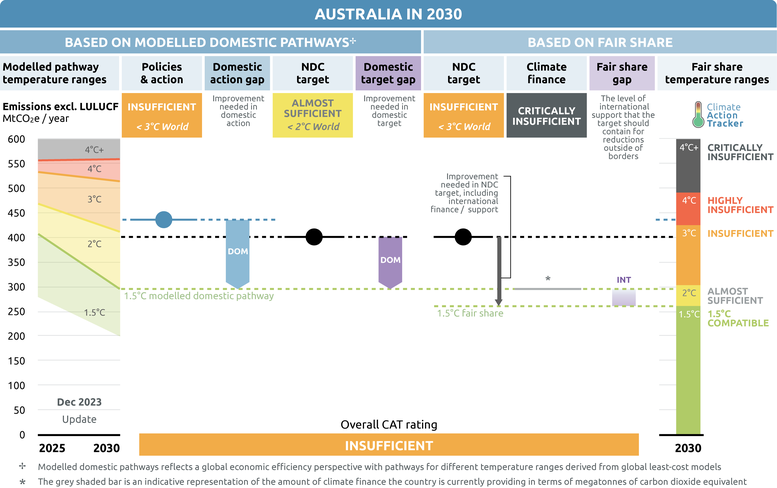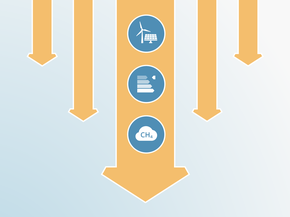Targets
Target Overview
In an effort to estimate the actual emissions reduction impact of a target, the CAT excludes emissions from land use, land use change and forestry from NDC targets. Australia’s NDC targets a 2030 emissions reduction of 43% below 2005 levels.
We calculate Australia’s 2022 NDC target to be 401 MtCO2e (408 MtCO2e with AR5 GWPs) in 2030 excluding LULUCF, rating this target “Almost sufficient” compared to modelled domestic pathways, and “Insufficient” for its fair share of global efforts, although the target value has increased between 2022 and 2023 because of the doubling of 2030 LULUCF sequestration estimates (see LULUCF section).
In October 2021, Australia released a long-term emissions reduction plan for achieving net zero emissions by 2050, also submitted as a Long-Term Strategy (LTS) to the UNFCCC. However, the scenarios presented in the strategy only reduce emissions by 60% below 2005 levels, excluding LULUCF.
The NDC update includes the objective of reaching net zero by 2050. However, there is still little clarity on how net zero might be achieved, as the net zero strategy is still under preparation (see net zero target section for details).
In September 2022, the Government enshrined its target into legislation, with the Act containing a clause that any future targets must be a progression beyond current commitments.
| AUSTRALIA - Main climate targets |
|---|
| 2030 NDC target | ||
|---|---|---|
| Formulation of target in NDC |
43% below 2005 levels by 2030 (including LULUCF) (Implemented as an absolute target for 2030, and as an emissions budget covering the period 2021-2030) |
|
| Absolute emissions level in 2030 excl. LULUCF |
401 MtCO2e (408 using AR5 GWPs) in 2030 [6% below 1990 levels] [25% below 2010 levels] Note: These figures change regularly based on Australian Government data updates. |
|
| Status | Submitted on 16 June 2022 | |
| Net zero target | ||
|---|---|---|
| Formulation of target |
Australia aims to reach net zero by 2050 The target covers all GHG emissions and all sectors of the economy. The target excludes both international aviation and shipping. Australia’s Long-term Emissions Reduction Plan indicates it plans to rely on international and domestic offsets for 10% of reductions required to reach net zero by 2050. |
|
|
Absolute emissions level in 2050 excl. LULUCF and international credits |
211 MtCO2e/yr (215 using AR5 GWPs) [50 below 1990] [61 below 2010] Note: These figures change regularly based on Australian Government data updates. |
|
| Status | Submitted on 29 October 2021 | |
NDC updates
Australia submitted a stronger target to the UNFCCC in June 2022 (Australian Government, 2022). The new target is a 43% reduction of greenhouse gas emissions by 2030 below 2005 levels, including LULUCF.
The June 2022 NDC includes a set of new policies measures such as investment into batteries, solar, and the electricity grid to accelerate renewables, a fund for decarbonising industry, and a declining emissions baseline for the Safeguard Mechanism (See the policies and action section).
The target will be implemented as both an absolute target and an emissions budget which declines on a linear trajectory. This should ensure mitigation efforts will be continuous over the budget period, with year-by-year reductions, which creates more substantial reductions across time. The 2022 NDC reaffirms Australia’s target to achieve net zero emissions by 2050. The objective has been enshrined into law by the Climate Bill adopted in 2022.
The NDC also indicates it will make adjustments for “internationally transferred mitigation outcomes” in line with Article 6 of the Paris Agreement, indicating it is also open to using international carbon credits, potentially as a buyer or seller. At present, the detailed rules and quality standards for making use of Article 6 as an ambition raising mechanism are still pending, making it difficult to assess whether they can offer a meaningful contribution to emissions reductions. Regardless, Australia should first improve its NDC target and climate finance contributions to align with a 1.5°C Paris Agreement Compatible pathway and focus on reducing its domestic emissions instead of relying on international carbon credits.
The updated NDC states Australia will not use carryover from past overachievement from previous (Kyoto Protocol) targets to meet its 2030 target. This is the first time the Australian government has explicitly ruled this out. The government must also ensure carryover is not used from the emissions budget or the absolute target for future targets. Carryover significantly lowers the actual emissions reductions and is neither legitimate nor defensible under the Paris Agreement (Climate Analytics, 2019).
Australia regularly updates its National Inventory data. Updates to the targets baseline year of 2005 impact the NDC target in terms of absolute emissions (Department of Climate Change, 2023f).
| AUSTRALIA - History of NDC updates | First NDC | Glasgow NDC update | 2022 NDC update |
|---|---|---|---|
| Submitted to UNFCCC | 9 November 2016 | 28 October 2021 | 16 June 2022 |
| 1.5°C compatible |
|
|
|
| Stronger target | N/A |
|
|
| Fixed/absolute target |
|
|
|
| AUSTRALIA | First NDC (2016) | 2021 NDC update | 2022 NDC update |
|---|---|---|---|
| Formulation of target in NDC |
26-28% below 2005 levels by 2030 (including LULUCF) (To be developed into an emissions budget for 2021-2030) |
26-28% below 2005 levels by 2030 (including LULUCF) (To be implemented into an emissions budget) |
43% below 2005 levels by 2030 (including LULUCF) (To be implemented as an absolute target for 2030 and as an emissions budget) |
| Absolute emissions level [excl. LULUCF] | 492-504 MtCO2e in 2030 | Unchanged | 401 MtCO2e in 2030 (408 using AR5 GWPs) |
|
Emissions compared to 1990 and 2010 [excl. LULUCF] |
16-18% above 1990 levels 6-8% below 2010 levels |
Unchanged |
6% below 1990 levels 25% below 2010 levels |
| CAT rating |
Overall rating*: Highly Insufficient |
Domestic target: Insufficient Fair share target: Highly Insufficient |
Domestic target: Almost sufficient Fair share target: Insufficient |
| Sector coverage | Economy-wide | Economy-wide | Economy-wide |
| Separate target for LULUCF | No | No | No |
| Gas coverage | All greenhouse gases | All greenhouse gases | All greenhouse gases |
| Target type | Absolute emissions from base year |
Absolute emissions from base year Multi-year emissions budget (2021-2030) |
Absolute emissions from base year Multi-year emissions budget (2021-2030) |
* Before September 2021, all CAT ratings were based exclusively on fair share and only assessed a country’s target.
Analysis of earlier NDC developments:
CAT rating of targets

The CAT rates NDC targets against what a country should be doing within its own borders as well as what a fair contribution to achieving the Paris Agreement’s long-term temperature goal would be. To assess targets against the fair share, we consider both a country’s domestic emission reductions and any emissions it supports abroad through the use of market mechanisms or other ways of support, as relevant.
Australia does not intend to use market mechanisms and will achieve its NDC target through domestic action alone. We rate its NDC target against both domestic and fairness metrics.
Australia has an NDC emissions reduction target of 43% below 2005 levels by 2030, including LULUCF. However, this target is dependent on LULUCF sequestration estimates, which fluctuate widely year on year. The target equates to about a 24% reduction below 2005 historical emissions by 2030 when LULUCF is excluded, or an absolute value of 401 MtCO2e excluding LULUCF in AR4 values (408 MtCO2e with AR5 GWPs). The CAT rates Australia’s NDC target as “Almost sufficient” when compared to the level of reductions needed within its borders.
The “Almost sufficient” rating indicates that Australia’s NDC target in 2030 is not yet consistent with limiting warming to 1.5°C but could be, with moderate improvements. If all countries were to follow Australia’s approach, warming could be held below—but not well below—2°C.
Analysis of the effect of the NDC on likely fossil fuel and industrial greenhouse gas emissions is made difficult by the fact that the NDC target includes LULUCF emissions, which have been substantial in the past and fluctuate significantly. LULUCF sink levels have almost doubled in 2021 compared to 2020, and their 2030 forecasts have been multiplied by close to four between the 2021 and the 2023 projections. See the assumptions section for further details.
We rate Australia’s 2030 emissions reduction target as “Insufficient” when compared to its fair share emissions allocation. The “Insufficient” rating indicates that Australia’s fair share target in 2030 needs substantial improvements to be consistent with limiting warming to 1.5°C. Australia’s target is at the least stringent end of what would be a fair share of global effort, and is not consistent with limiting warming to 1.5°C, unless other countries make much deeper reductions and comparably greater effort. If all countries were to follow Australia’s approach, warming would reach over 2°C and up to 3°C.
Further information on how the CAT rates countries (against modelled pathways and fair share) can be found here.
Australia’s international climate finance is rated “Critically insufficient” (see below) and is not enough to improve Australia’s fair share rating.

Australia’s international public climate finance contributions are rated “Critically insufficient”. Australia has committed to increase its climate finance but contributions to date have been very low compared to its fair share. To improve its rating, Australia needs to increase the level of its international climate finance.
The biggest four Australian private banks have committed to stop funding coal thermal projects abroad (Market Forces, 2021). At COP26, Australia failed to commit to ending new direct public support for the international fossil fuel energy sector, unlike the UK, USA, New Zealand and others (UK Government, 2021b). At COP28, Australia finally joined the Clean Energy Transition Partnership, pledging to end direct public investments into international fossil fuels projects within a year (Minister for Foreign Affairs & Minister for Climate Change and Energy, 2023a). This led the CAT to improve Australia’s fossil fuel finance overseas rating from “Highly Insufficient” to “Insufficient”. However, this does not improve Australia’s overall climate finance rating. To receive a better rating, Australia must increase the level of its international climate finance.
Australia has pledged AUD 3bn towards climate finance, encompassing both mitigation and adaptation, for the 2020-2025 period. This amount represents an increase from an earlier commitment of AUD 2bn, which in turn was a raised target from an initial AUD 1.5bn for the same timeframe (Australian Government, 2020b; Department of Foreign Affairs, 2023; Government of the United Kingdom, 2021; UK Government, 2021a). However, concerns remain that this commitment will include the relabelling of existing funds (Oxfam, 2023).
While total climate-related development finance more than doubled between 2018 and 2020, the development finance for projects where climate mitigation and adaptation was a principal component of the assistance was halved (OECD, 2023).
Australia’s climate finance focuses on adaptation projects, which received 66% of the funds for the year 2021/22. During that year, climate finance increased by USD 103m to reach USD 449m. The Federal Government withdrew from the Green Climate Fund in 2019 and declined to put funds into its replenishment (Mathiesen, 2019). It finally reintegrated it in 2023, albeit with a “modest contribution” of AUD 50 million (ABC, 2023a; Minister for Foreign Affairs & Minister for Climate Change and Energy, 2023b).
The Department of Foreign Affairs and Trade released a new international development policy in August 2023, that mandates the consideration of climate risks in all bilateral and regional Development Partnership Plans. It also stipulates that from 2024/25, a minimum of half of the new bilateral and regional investments over AUD 3m should focus on climate change objectives, with plans to increase this proportion to 80% by 2028/29 (Department of Foreign Affairs and Trade, 2023a, 2023b).
Australia's lack of action on climate finance is central to the discussions around COP31. Australia is proposing to host the 2026 Conference of Parties in collaboration with 'the Pacific family'. In March 2023, governments from Vanuatu, Tuvalu, Tonga, Fiji, Niue, and the Solomon Islands issued the Port Vila Resolution.
This resolution calls for, among other things, more public and private funding to facilitate a fair transition away from fossil fuels, increased grant-based financing and direct investments in the region, and a reform of the global climate finance framework (Australia Institute, 2023a). Australia has also committed to supporting the Pacific Resilience Facility, focusing on small-scale climate-related resilience projects. At COP28, the government revealed it will contribute AUD 100m to the fund (Minister for Foreign Affairs & Minister for Climate Change and Energy, 2023b; Prime Minister, 2023).
Net zero target
Australia included the target to achieve net zero emissions by 2050 in its updated NDCs in October 2021 and June 2022. Details were published in the Long-term Emission Reductions Plan, submitted as its Long-term Strategy (LTS) to the UNFCCC, in October 2021. The Climate Change Bill 2022 enshrined the 2050 target in the law. The government is currently preparing an update of the 2050 climate strategy.
The Long-term Emission Reductions Plan leaves a significant emissions gap between its planned reductions and its net zero target in 2050. The strategy presents ambiguous emissions scenarios that reduce emissions by 60 excluding LULUCF.
The Long-term Emission Reductions plan depends on global technology trends to achieve 15% of its required reductions. An additional 10% is anticipated from international or domestic offsets. Finally, “future technology breakthroughs” are projected to contribute another 15% towards reducing emissions below the 2005 baseline. Overall, the plan relies heavily on the future development of low-emissions technology with no plans to phase out coal, curb fossil fuel exports, or hold heavy polluters accountable.
Further analysis of Australia’s net zero emissions can be found here.
Further analysis
Latest publications
Stay informed
Subscribe to our newsletter




